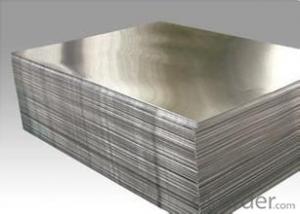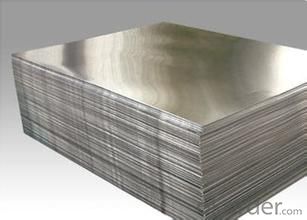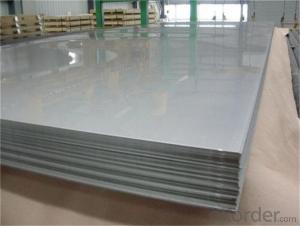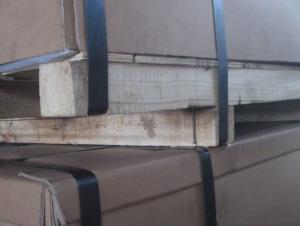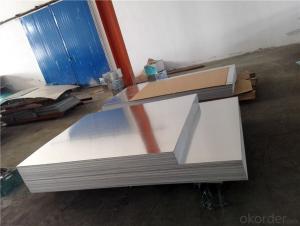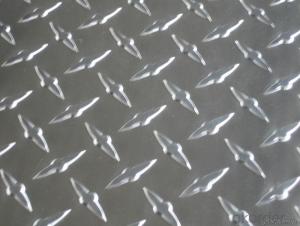Wholesale Checkered Aluminum Sheets - Aluminum Sheer for Any
- Loading Port:
- China Main Port
- Payment Terms:
- TT OR LC
- Min Order Qty:
- -
- Supply Capability:
- -
OKorder Service Pledge
OKorder Financial Service
You Might Also Like
Aluminium alloys with a wide range of properties are used in engineering structures. Alloy systems are classified by a number system (ANSI) or by names indicating their main alloying constituents (DIN and ISO).
The strength and durability of aluminium alloys vary widely, not only as a result of the components of the specific alloy, but also as a result of heat treatments and manufacturing processes. A lack of knowledge of these aspects has from time to time led to improperly designed structures and gained aluminium a bad reputation.
One important structural limitation of aluminium alloys is their fatigue strength. Unlike steels, aluminium alloys have no well-defined fatigue limit, meaning that fatigue failure eventually occurs, under even very small cyclic loadings. This implies that engineers must assess these loads and design for a fixed life rather than an infinite life.
Another important property of aluminium alloys is their sensitivity to heat. Workshop procedures involving heating are complicated by the fact that aluminium, unlike steel, melts without first glowing red. Forming operations where a blow torch is used therefore require some expertise, since no visual signs reveal how close the material is to melting. Aluminium alloys, like all structural alloys, also are subject to internal stresses following heating operations such as welding and casting. The problem with aluminium alloys in this regard is their low melting point, which make them more susceptible to distortions from thermally induced stress relief. Controlled stress relief can be done during manufacturing by heat-treating the parts in an oven, followed by gradual cooling—in effect annealing the stresses.
The low melting point of aluminium alloys has not precluded their use in rocketry; even for use in constructing combustion chambers where gases can reach 3500 K. The Agena upper stage engine used a regeneratively cooled aluminium design for some parts of the nozzle, including the thermally critical throat region.
Another alloy of some value is aluminium bronze (Cu-Al alloy).
Aluminium foil acts as a total barrier to light and oxygen (which cause fats to oxidise or become rancid), odours and flavours, moistness, and germs, it is used broadly in food and pharmaceutical packaging. The purpose of aluminium is to make long-life packs (aseptic processing|aseptic packaging) for drinks and dairy goods, which allows storing without refrigeration. Aluminium foil containers and trays are used to bake pies and to pack takeaway meals, ready snacks and long life pet foods.
Aluminium foil is widely sold into the consumer market, often in rolls of 500 mm (20 in) width and several metres in length.It is used for wrapping food in order to preserve it, for example, when storing leftover food in a refrigerator (where it serves the additional purpose of preventing odour exchange), when taking sandwiches on a journey, or when selling some kinds of take-away or fast food. Tex-Mex restaurants in the United States, for example, typically provide take-away burritos wrapped in aluminium foil.
Aluminium foils thicker than 25 μm (1 mil) are impermeable to oxygen and water. Foils thinner than this become slightly permeable due to minute pinholes caused by the production process.
- Q: Can aluminum sheet be used for electrical grounding applications?
- Indeed, aluminum sheet finds utility in electrical grounding applications. It possesses remarkable conductive properties, rendering it apt for employment in grounding systems. Its low resistance and exceptional electrical conductivity make it a common choice in diverse electrical applications. With the capability to proficiently transport electrical current and securely disperse it into the ground, aluminum sheet guarantees the safeguarding of electrical systems and averts potential electrical dangers. Moreover, the lightweight and corrosion-resistant attributes of aluminum establish it as a favored option for grounding applications across numerous industries, encompassing construction, automotive, and aerospace.
- Q: Aluminum and oxygen gas react to produce aluminum oxide
- Aluminium oxide is Al2O3, so there are 3 oxygen atoms for every 2 aluminium atoms. Divide 75 by the relative atomic mass of oxygen (15.9994). That is proportional to the number of oxygen atoms. Then divide by 3 and multiply by 2. This gives a number proportional to the number of aluminium atoms. Then multiply this by the relative atomic mass of aluminium (26.981529) to give the mass of aluminium required in grams.
- Q: Who knows the ceiling size of aluminum hang-parcel?
- Size of aluminum buckle plate: general size for home decoration: 300mm×300mm、300*450mm.300*600mm, general size for engineering: 600*600mm、800*800mm、 300*1200mm、600*1200mm. aluminum buckle plate takes aluminum alloy as base and is formulated by rough shape cutting, angle of shear and compression moulding forming. We use various coating to process aluminum buckle plate’s surface, generating aluminum buckle plate products. There are two types aluminum buckle plates: one is integrated aluminum buckle plate for home decoration, another is engineering aluminum buckle plate. With the feature of various colors, good for decoration and good weather resistance, aluminum buckle plate is broadly used for outdoor wall decoration, indoor top grade home decoration and advertisement decoration,etc.
- Q: Can the export quality of China's aluminum plate meet the requirement of ASTM B 209? Is this requirement for our country? Master the exhibitions, O (a _ U) O thank you
- This is not quite clear, you Baidu once "work standard net" in "work standard net" check to know!
- Q: Are aluminum sheets suitable for food-grade applications?
- Yes, aluminum sheets are suitable for food-grade applications. Aluminum is a widely used material in the food industry due to its excellent properties. It is non-toxic, corrosion-resistant, and has a high thermal conductivity, making it a suitable choice for food processing and packaging. Aluminum sheets can be used to make food-grade containers, trays, and packaging materials. They are also commonly used for cooking utensils, such as baking sheets and foil, which are safe to use in direct contact with food. Additionally, aluminum sheets can be easily cleaned and sanitized, making them a hygienic choice for food-grade applications.
- Q: Are aluminum sheets suitable for reflective signage?
- Yes, aluminum sheets are suitable for reflective signage. Aluminum is a versatile material that is commonly used for reflective signs due to its durability, lightweight nature, and ability to reflect light. It has a high reflectivity index, making it ideal for applications where visibility is crucial, such as road signs, traffic signs, and safety signs. Aluminum sheets can be coated with reflective films or paints to enhance their reflective properties, ensuring maximum visibility even in low light conditions. Additionally, aluminum is resistant to weathering, corrosion, and fading, making it a long-lasting and cost-effective choice for reflective signage.
- Q: Can aluminum sheets be used for boat building?
- Boat building can indeed incorporate aluminum sheets. The lightweight quality, durability, and resistance to corrosion make aluminum a favored material for constructing boats. Small recreational boats, larger yachts, and even commercial vessels commonly employ aluminum sheets in their construction. These sheets offer numerous benefits, including ease of manipulation, a remarkable strength-to-weight ratio, and minimal upkeep requirements. Furthermore, aluminum boats are esteemed for their exceptional buoyancy, stability, and fuel efficiency. All in all, utilizing aluminum sheets is a suitable and dependable choice for boat building.
- Q: I am trying to find a BRUSH ON type glue to adhere aluminium foil to a plastic model. scotch super 77 works great but dries way to fast and blows small pieces all over. white glue just dont work and superglue eats the plastic. I could use some help
- Gluing Aluminum
- Q: Are the aluminum sheets available in different grades?
- Indeed, there are various grades of aluminum sheets obtainable. Aluminum is widely utilized in different sectors owing to its lightweight, resistance to corrosion, and impressive strength-to-weight ratio. To cater to diverse applications, distinct grades of aluminum sheets have been tailored. Among the frequently encountered grades are 1100, 3003, 5052, 6061, and 7075. Each grade possesses distinctive qualities and attributes, encompassing strength, formability, weldability, and machinability. The selection of a grade relies on factors like the intended purpose, environmental circumstances, and desired characteristics of the end product.
- Q: How do I calculate the weight of aluminum sheet? What is the density?
- Weight by volume * density. With the quality, volume density.
Send your message to us
Wholesale Checkered Aluminum Sheets - Aluminum Sheer for Any
- Loading Port:
- China Main Port
- Payment Terms:
- TT OR LC
- Min Order Qty:
- -
- Supply Capability:
- -
OKorder Service Pledge
OKorder Financial Service
Similar products
Hot products
Hot Searches
Related keywords

